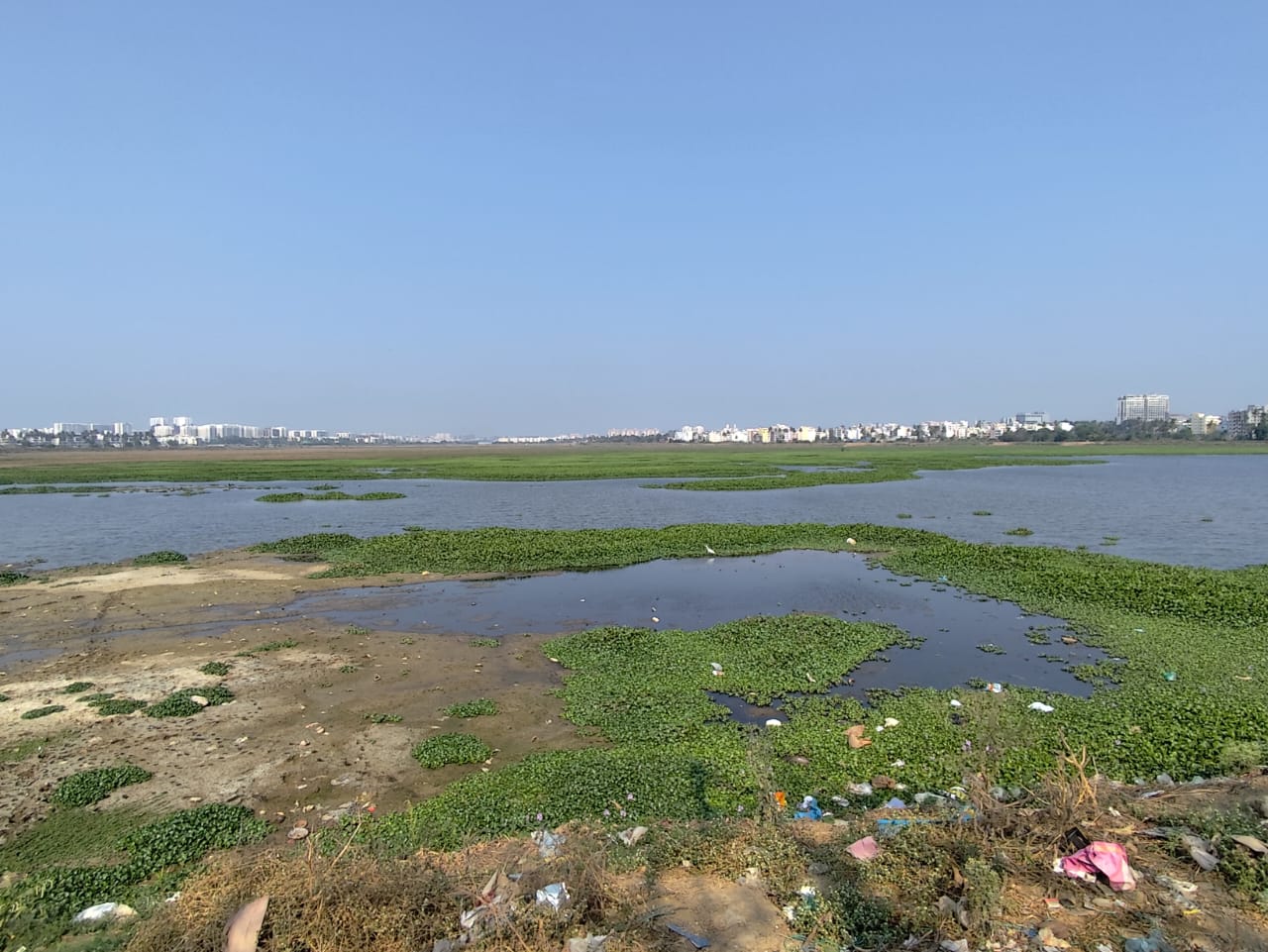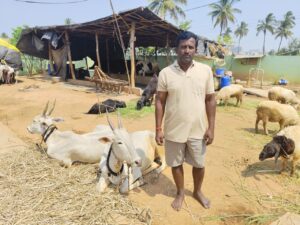Varthur (445 acres) and Bellandur (950 acres) lakes once sustained vibrant village life—providing clean drinking water, supporting farming, and serving daily needs—making them among the most thriving outskirts of Bengaluru
Published May 07, 2025 | 9:00 AM ⚊ Updated May 24, 2025 | 7:45 PM

Once a lifeline, now a threat: Farmers grapple with toxic waters of Varthur and Bellandur Lakes
Synopsis: Once vital to farming and village life, Bengaluru’s Varthur and Bellandur lakes have turned toxic. Once thriving with agriculture and clean water, both now suffer from pollution, drying beds, foul smells, and unusable water, leaving nearby communities struggling to adapt. Once-lush landscapes have given way to dust, sewage drains, and dying fields, marking a tragic environmental decline
Once upon a time, there were two twin lakes in Bengaluru, Varthur lake and Bellandur lake where farmers cultivated crops including ragi, paddy and different types of vegetables. While Varthur lake measures 445 acres, Bellandur measures 950 acres of land. All the villagers drank clean water from lake, women would use it for domestic purposes, men brought their cows to the lakes to bathe them. All in all, Varthur and Bellandur were the most beautiful and thriving villages in the outskirts of the city.
Cut to 2025, roads are filled with dust, half of Varthur lake has gone dry, a separate storm water drain is created so that sewage water does not enter the lake. However, the lake has lost its charm and there are fewer fields close to the bed of the lake. Similarly, Bellandur lake is fenced now, there is a foul smell surrounding the lake, grass and hyacinth is grown on the bed of the lake now. In simple words, the water of both the lakes are not fit for drinking or even domestic purposes.
Manjunath (60) a resident of Varthur village was born and brought up there. He said that though Bengaluru got the name of Silicone city after the Information Technology sector entered the city in 1900s, it changed the identity of the village and the people living there.
He remembered the good old days in 1907 which he witnessed in Varthur and said, “There were only 3000 homes in our village and the entire village had only two borewells from which we used to fetch drinking water. Lake water was used for cultivation and all the other domestic purposes. The entire KR Market was filled with produce grown by villagers here. There were only two borewells because the water bed was recharged with clean lake water and rains and they never went dry.”
He continued, “The IT sector sprung up in 1900s and the entire identity of our villagers changed. We don’t have problems for apartment coming up in the surrounding areas, but the sewage and waste water was all let into the lakes. There were a lot of encroachments on the lake bed. It was in 2016, when the frothing and fire in the lake caught attention of media. The government was forced to take stringent action against encroachments and save the lake from dying.”
Manjunath and several others stressed it lead to migration of farmers from Varthur to Kolar, Malur, Mulabagilu and others. He said, “The farmers who once thrived here sold their land to real estate persons, constructors and developers and left to various areas. Every year, the government announces spending crores for desilting purpose but it is not done properly, they do an incomplete job leaving the lake in bad condition.”
Venkat Reddy is another villager who still owns ten acres of land near Varthur village. He said, “We cultivated rice and paddy using the lake water in Varthur. There were days when we drank water directly from these lakes. The water was clean and clear. When the lake got polluted, we could not grow paddy, ragi or even vegetables. You might not believe that each house had its own granary to stock these grains after selling them in the markets of Bengaluru and Kolar.”
Venkat continued, “We even dug up three bores in my field, spending lakhs of rupees so that we could cultivate the crops. But the chemicals and other toxic content has seeped into the lower layers of Earth to an extent that froth and dirt would come out of borewells during rainy season. During summer, the borewells went dry. In simple words, borewells failed.”
Despite the bad condition of water in Varthur, Venkat wants to retain his 10 acres and not sell it to others. He said, “No I will not sell that land. We don’t cultivate anything now. There is too much of grass grown in the land. A few high rise buildings/ apartments have sprung up now. The reason behind not selling it is because the land holds a sentimental value to me. It was passed from my grandfather to father and then to me. I want my children and grandchildren also to know that we had fields where we cultivated rice and ragi.”
Similarly, Jagadish Reddy, a resident of Varthur lake who was born and brought up in Varthur village, explained, “Once upon a time, agriculture thrived in Varthur and Bellandur. We cultivated all kinds of commercial crops. Unfortunately, the pollution lead everybody to stop growing crops. Some of them sold their acres of land to big developers, real estate and others. Other farmers chose to stay back and now they grow ornamental flowers used for decoration in weddings and different occasions.”
South First met one such family that had shifted its cultivation from growing crops to growing ornamental flowers. Chinnamma who is in her late fifties has been growing ornamental flowers for more than a decade now. Her small piece of land is close to Varthur lake. She said, “We cultivated crops like paddy and ragi, after this water got polluted, we started growing ornamental flowers. Since it is only used for decoration and not consumption, it is safe to grow these flowers. We sell them in the K R Market in Bengaluru. Just look at the water in the lake, it has turned black and grey in colour”
She added, “We can’t explain the problems that we have to go through here. Once upon a time, cultivating land near lake was a boon to us now it is a bane. The government has diverted this lake water into storm water drain which is next to my fields. Whenever it rains heavily, all that water floods my fields. In such times, we can’t earn a penny because all the dirty water enters my fields.”
Chinnamma said, “Either the government should have constructed two rajacaluveys or the existing one should have been bigger in size.”

Nagaraj Venkatesh, dairy farmer at Varthur lake
Despite high rise buildings that have sprung up in and around Varthur lake, Nagraj Venkatesh, has continued to work as a dairy farmer. He has a duplex house and enough space for his seven cows, including five jersey and two naati cows, few sheep, goat two dogs that guard his house.
His house is located in Varthur’s Jamma Masjid road, Thigalara beedi. He said, “Only few families are into farming here. After the pollution of this lake, it was impossible to sustain agriculture. A few dairy farmers are living in and around the lake. It is not easy for us also but we are able to grow grass in our fields required to feed our cows. It is costlier if you have to buy it from elsewhere.”
Rajanna, a rice mill owner from Ramagondanahalli near Varthur, is among the many whose livelihood collapsed as pollution overtook the once-thriving Bellandur and Varthur lakes. Two decades ago, he ran two successful rice mills catering to local paddy farmers who earlier had to transport their harvest to Tamil Nadu or Hosur due to the lack of milling facilities nearby.
“Seeing the need, I set up a rice mill in Varthur village, and soon, farmers were relieved, and I was making decent profits,” Rajanna recalled. Encouraged by the response, he later opened a second mill on Chikka Tirupathi Road to support farmers from Chikkaballapur and Doddaballapur.
However, the rise of Bengaluru’s IT boom marked the decline of agriculture in the region. “As new residential areas emerged, untreated sewage from homes and apartments flowed into the lakes. Crops failed, farmers stopped cultivation, and my mills became unsustainable,” he said.
Eventually, Rajanna shut both mills and sold the machinery for scrap, recovering just a few lakhs. “I ended up with a loss of nearly ₹50 lakh. Those were the good days, but they’re gone now,” he lamented.
The story of Bellandur Lake mirrors that of its twin, Varthur. Once among the largest lakes in Bengaluru, sprawling over 950 acres, Bellandur is now choked with hyacinth and surrounded by high-rise apartments. Once fertile agricultural land has vanished, sold off to real estate developers. Despite crores spent by the Karnataka government on restoration, the lake emits a foul stench that can be sensed from 200 metres away.
Rajan, a former farmer from Bellandur, used to own 10 acres of land near the lake. “When the apartments came up, they started discharging untreated sewage into the lake. The water became too toxic for farming. We had no choice but to sell our land for ₹60 lakhs. Today, it’s worth ₹5 crores,” he said. Rajan now earns his livelihood by cutting and selling the wild grass growing near the lakebed to cattle owners in Shivajinagar.
Anthony, another long-time resident, shared a similar fate. He once owned four acres of land, which he sold due to water contamination. “The grass near the lake was once rich and ideal for cattle. Now it’s dry, and the yield is poor. I used to supply to multiple Goushalas like Adugodi and Koramangala, but now, I only sell to Shivajinagar. My income has fallen sharply,” he said.
Thayamma, a 55-year-old farmer, lives in a modest home just behind Bellandur Lake. Though she doesn’t own any land, she cultivates leafy greens on a small patch in the lake’s buffer zone. “I’ve worked in others’ fields all my life. I have two daughters, both married, and I didn’t want to work as domestic help. So I began growing a few greens here,” she said.
She grows spinach (palak), Malabar spinach (basale soppu), curry leaves, and fen

Thayamma, farmer at Bellandur lake
ugreek (menthe soppu), using stored rainwater instead of the polluted lake water. “I don’t grow in large quantities—just enough for a few families in the area and for my own household use,” she added.
While officials have visited the area a couple of times, Thayamma says local residents spoke on her behalf. “They allowed me to continue. Better we grow food here than let this land turn into a garbage dump,” she said.
Srinivas, another Bellandur resident, tends a small garden near the lake as well. Though the land belongs to someone else, he helps cultivate it. “My mother is old and prefers staying active. So we’ve created a kaithota—a little home garden—with green chillies, cherry tomatoes, spinach, and flowers like hibiscus and kanakambara. I work full-time as an electrician,” he explained.
(Edited by Ananya Rao)
